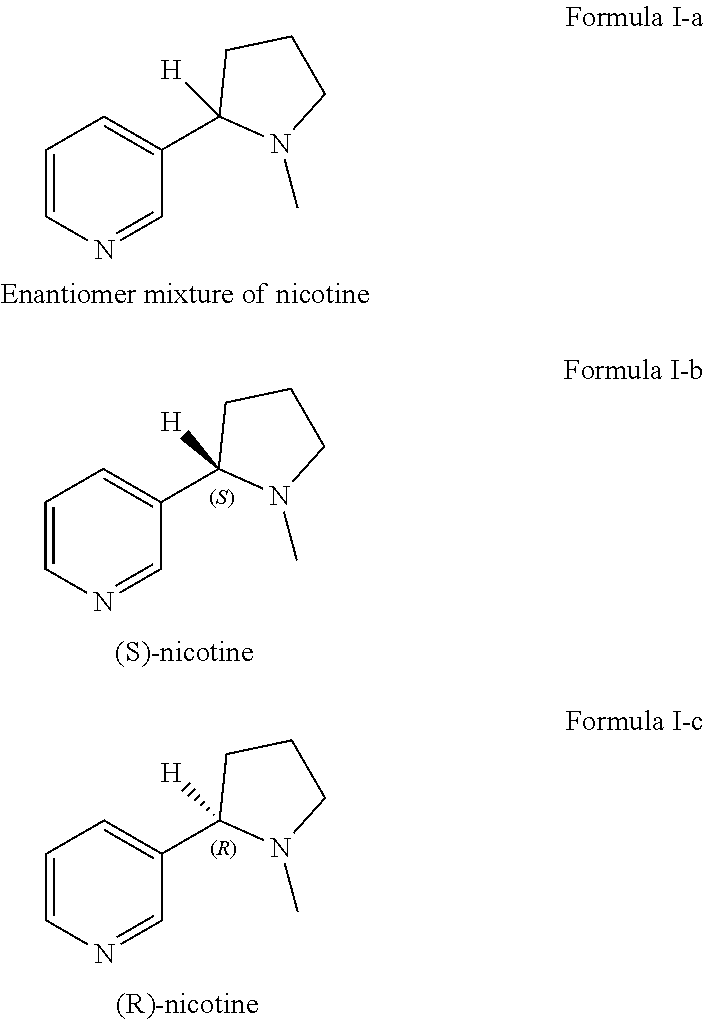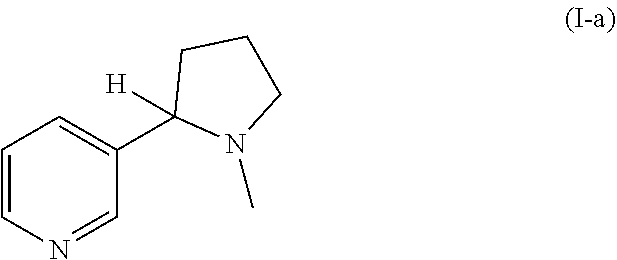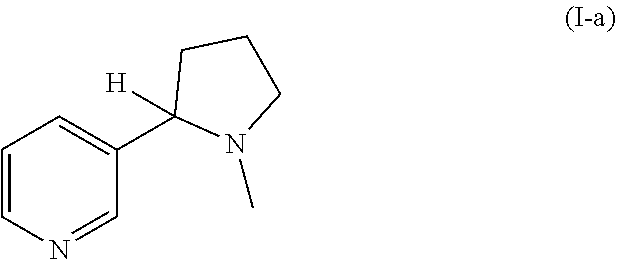Preparation of racemic nicotine by reaction of ethyl nicotinate with n-vinylpyrrolidone in the presence of an alcoholate base and subsequent process steps
a technology of alcoholate base and racemic nicotine, which is applied in the field of preparation of racemic nicotine, can solve the problems of high cost of known syntheses, environmental toxicities, and difficult to achieve the effect of organic bas
- Summary
- Abstract
- Description
- Claims
- Application Information
AI Technical Summary
Benefits of technology
Problems solved by technology
Method used
Image
Examples
example 1
[0076]General Procedure 1 to Prepare Racemic Nicotine
[0077]1.0 eq. of ethyl nicotinate, toluene (50.0 g or 4.4 parts by weight related to ethyl nicotinate) and optionally ethanol (1 g, 0.09 parts by weight related to ethyl nicotinate), and 1.3 eq. of sodium ethoxide are heated under stirring to 80° C. to 85° C. 1.2 eq. of 1-vinyl-2-pyrrolidone (NVP) were charged to the reaction mixture at 80° C. to 85° C. during 1.5 to 2.0 hours under anhydrous conditions. The reaction was run at 95° C. to 100° for 3 hours. Then the reaction is completed, and the reaction mixture is distilled during 2 hours to remove some of the solvents (azeotrope containing 68 wt. % ethanol and 32 wt. % toluene). The remaining reaction mixture is poured on HCl (aq., 30% in water; 58.0 g or 4.4 eq.). Low boiling components like acetaldehyde (from the “vinyl” component), ethanol and gaseous CO2 were removed by distillation. When the reaction temperature reached 105° C., distillation was stopped and the reaction mixt...
example 2
n Step
[0083]1.0 g racemic nicotine, as obtained by the previous examples, was mixed at room temperature with ethanol (1) and 2.2 g tartaric acid (DBTA) (1 equivalent). The mixture was refluxed for a few minutes and cooled down to room temperature (about 20° C.). Precipitation started, and the mixture was stirred overnight (10 to 12 hours) at 20° C. A precipitate that formed was filtered, washed with ethanol (2). The crude product was dissolved in ethanol (3). The mixture was refluxed for a few minutes and cooled down to room temperature. Precipitation started, and the mixture was stirred overnight (10 to 12 hours) at 20° C. The precipitate was filtered and washed with ethanol (4). The product was dried and the pure product was obtained.
[0084]3.2 g nicotine-L-DBTA as produced in Example 1b, sample 1, were suspended in 7.2 g water and 7.2 g toluene. Aqueous ammonia (25% by weight) was added until the pH was between 9.8 and 10.4. The phases were separated, and the aqueous phase was ext...
example 3
[0088]Equivalent amounts of dibenzoyl-D-tartaric acid (23.2 g) and racemic nicotine (10.0 g) were dissolved in ethanol and stirred for 1 hour, refluxed for 15 minutes, cooled to room temperature and stirred for another hour. (R)-nicotine dibenzoyl-D-tartrate was obtained. After recrystallization in an iso-propanol-methanol mixture (1.0:0.3), (R)-nicotine was obtained. The results are given in the following Table 3.
TABLE 3amounts for samples in Comparative Example 1DBTAEthanolYieldChiral purity100%10.060.0%87.9%D-DBTA(S)-isomer
PUM
| Property | Measurement | Unit |
|---|---|---|
| temperature | aaaaa | aaaaa |
| temperature | aaaaa | aaaaa |
| temperature | aaaaa | aaaaa |
Abstract
Description
Claims
Application Information
 Login to View More
Login to View More - R&D
- Intellectual Property
- Life Sciences
- Materials
- Tech Scout
- Unparalleled Data Quality
- Higher Quality Content
- 60% Fewer Hallucinations
Browse by: Latest US Patents, China's latest patents, Technical Efficacy Thesaurus, Application Domain, Technology Topic, Popular Technical Reports.
© 2025 PatSnap. All rights reserved.Legal|Privacy policy|Modern Slavery Act Transparency Statement|Sitemap|About US| Contact US: help@patsnap.com



